1886 – The Bay View Tragedy occurs, as militia fires upon a crowd of protesters in Milwaukee, Wisconsin killing seven.
The Posse After the Reno Gang
Enter now to win a copy of the
Principles of Posse Management:
Lessons from the Old West for Today’s Leaders.

Newspaper readers from Hartford, Connecticut, to Portland, Oregon, were shocked to read about the bold and daring robbery of the Ohio and Mississippi Railroad on October 6, 1866. It was the first robbery of its kind. Banks and stage lines had been robbed before, but no one had perpetrated such a crime on a railroad. According to the October 20, 1866, edition of the Altoona Tribune, three masked bandits entered the car stopped at a station near Seymour, Indiana, with the idea of taking money from the Adams Express safe. They entered the car from the front platform, leveled their revolvers at the head of the guard on duty, and demanded he hand over the keys to the safe. He did so with no argument.
While one of the bandits stood guard, the others opened and removed the contents of one of the three safes which included more than $20,000 in cash. When the job was done, the desperadoes moved one of the safes to the door of the car, opened it, and tossed the box out. The heavy safe hit the ground hard, rolled, and came to a stop. One of the masked men pulled on the bell cord, and, as the engineer replied with the signal to apply the brakes, the robbers jumped out the train and made their escape.
The engineer saw the bandits leap off the train and speculated they were headed in the direction of Seymour. The train slowed to a stop and one of the agents for the Adams Express Company who was on the train hopped off and ran back to the station with the news of the robbery. He commandeered a handcar and recruited a few men to help him collect any evidence left behind by the thieves. On the agent’s way back to the train, he found the safe tossed from the car. The $15,000 inside had not been touched.
The Adams Express Company offered a $5,000 reward for the arrest and conviction of the robbers. A witness aboard the train the evening it was robbed told authorities he recognized the desperadoes who stole the money as the Reno brothers, John and Simeon, and one of their friends, Frank Sparks. Citizens and detectives alike began a vigorous search, but the brothers proved impossible to locate.
Unbeknownst to the Reno boys and the gang of outlaws with whom they associated, the Pinkerton Detective Agency had been hired to protect all Adams and Express Company shipments. Armed with the descriptions provided by the witness, Allan Pinkerton, head of the investigation firm, set out to find the culprits. Pinkerton traced the Renos to Seymour, a lawless community where rustlers, bandits, and cutthroats from all over the area gathered.
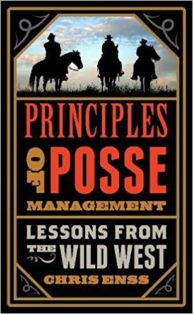
The Principles of Posse Management 2
I'm looking forward to hearing from you! Please fill out this form and I will get in touch with you if you are the winner.
Join my email news list to enter the giveaway.
"*" indicates required fields
To learn more about the posse after the Reno gang read
Principles of Posse Management: Lessons from the Old West for Today’s Leaders
This Day…
1933 – Nellie T. Ross takes office as the first female director of the US Mint
The Posse After Tom Bell
Enter now to win a copy of
Principles of Posse Management: Lessons From the Old West for Today’s Leaders

Tom Brown was nearly where Buck’s Creek poured out into the open plains when he came upon the posse. The sturdy and tenacious group of lawmen had been waiting for days for one of the members of the Bell gang to ride through the Northern California range. A couple of placer miners working a claim on the American River told Sacramento County detective Robert Harrison that Bell’s men rode through the area between holdups. Tom Brown, alias Sam Woodruff, didn’t fight the unfortunate situation he found himself. Without saying a word he stepped off his horse and surrendered his six-shooters. Detective Harrison was happy to relieve the bandit of his weapons.
Tom Bell, also known as the “gentlemen highway man”, was second only in notoriety to the cruel and bloodthirsty Joaquin Murrieta. His true name was Thomas J. Hodges, a native of Rome, Tennessee, where he was born in 1826. His parents were respected people and made sure he had a thorough education. He graduated from a medical institution, and shortly after receiving his diploma, joined a military regiment and proceeded to the seat of war in Mexico, where he served honorably as a non-commissioned officer until the close of the struggle.
Like thousands of others he was attracted to California by its golden allurements and began life as a miner. The hard work and privations of a miner’s life, coupled with a lack of success, caused him to follow in the footsteps of many, whose loose moral ideas led them into gambling as a means of making ends meet. Soon tiring of this, he took to the road, where he continued his games of chance, simply staking his revolver against whatever loose coin his victims had about them.
He was convicted of grand larceny in 1855 and sentenced to five years in the state prison at Angel Island.
In May 1855, he made his escape with half a dozen other prisoners, among whom were Bill Gristy, alias Bill White, James Webster, Ned Conners, and Jim Smith. These four remained together and formed the nucleus of the celebrated and notorious “Tom Bell gang,” that for nearly two years kept the state in a fever of excitement.
Management Principle Learned from the Posse After Tom Bell
Walk in Someone Else’s Shoes
Various members of the posse disguised themselves as outlaws and saloon patrons in order to collect the information needed to apprehend the criminals. Instead of figuratively walking in someone else’s shoes, posse members made it experiential. By doing this they were in a better position to propose solutions to potential problems and learned how to best achieve their objective.

The Principles of Posse Management 2
I'm looking forward to hearing from you! Please fill out this form and I will get in touch with you if you are the winner.
Join my email news list to enter the giveaway.
"*" indicates required fields
To learn more about Tom Bell and the posse who tracked him and his gang read
Principles of Posse Management: Lessons from the Old West for Today’s Leader
This Day…
1912 – The Beverly Hills Hotel opens on Sunset Boulevard in Beverly Hills, California
Lessons from the Old West for Today’s Leaders
Enter now to win a copy of
Principles of Posse Management: Lessons From the Old West for Today’s Leaders
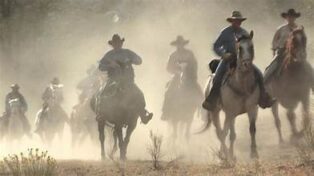
“Chris Enss’s engaging book, The Principles of Posse Management, takes you back in time to the Old West, where with incredible detail and fun anecdotes, she reveals many universal leadership tools that were surprisingly effective in keeping order at such a lawless time. Subsequently, many of these same tools are needed today within our own corporate climate. Read this fascinating book and reconnect to these powerful principles from the past.” – Sean Convey, executive vice president, Global Solutions and Partnerships, FranklinCovey
“Posses were created very strategically to catch the outlaws that sure had a ‘never give up’ way of life. I was fascinated by the stories and bravery that built our Western lifestyle.” – Lisa Bollin, CEO and director of design, Cowgirl Tuff Company

Throughout the month of May visit www.chrisenss.com to enter to win a copy of
Principles of Posse Management
This Day…
1872 – Jesse James‘ gang robs a bank of $1,500 in Columbia, Kentucky, killing bank employee Robert A.C. Martin during the crime
The Notorious Lola Montez
Enter now to win a copy of
Entertaining Women: Actresses, Dancers, and Singers in the Old West
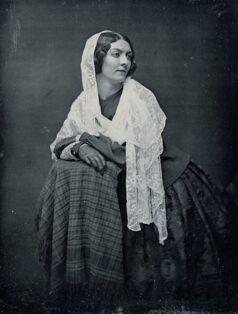
More than a hundred-sixty years ago citizens in New York were discussing with avid interest the approaching theatrical engagement in the city of a woman with a romantic Spanish name – and a titled one, no less – who had caused one monarch to lose his throne and had left a trail of affairs in her wake after a hectic zig-zag career of adventure and amour which had taken her pretty much all over the map of Europe.
This woman, who had been described as the most beautiful woman in Europe, whose comeliness, flashing, black eyes, crimson lips, intelligence and ready wit, few men had been known to resist, was now in the United States and was slated to appear in New York before traveling to California. Small wonder, then, that honest housewives shook their heads when their husbands and sons displayed too much interest in “that adventuress” and suggested that they had better stay at home that evening.
Nevertheless, a well-filled house greeted the celebrity from overseas. Enough New Yorkers passed their cash into the box office till to make her engagement well worthwhile.
Lola Montez was the attraction. The Countess of Landsfeld, as Lola was also known, may not have been the best dancer in the world in fact, one New York newspaperman reported that, in his opinion she was quite the worst, but the former uncrowned queen of Bavaria could hardly have been accused of being dull.
The audience had come to taste optically an exotic dish and Lola added a liberal dash of paprika. She included in her Iberian repertoire the “spider dance” a creation of her own, based on the most exotic of foreign sources, but watered down a bit for American consumption.
The “spider dance” was simple and titillating. Lola started the dance routine from the wings of the stage. She would twirl her way in front of the audience dressed in a pair of multicolored tights and a skirt cut just above her knee. After another few twirls she would end up under a canopy of corks hanging from the ceiling that had been painted black. The corks represented spiders falling from the sky. As the music reached fever pitch, she would spin around and around until she was tangled in the corks. Lola would spend the remainder of the dance twirling around trying to free herself from the corks.
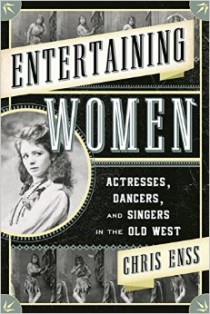
Entertaining Women 4
I'm looking forward to hearing from you! Please fill out this form and I will get in touch with you if you are the winner.
Join my email news list to enter the giveaway.
"*" indicates required fields
To learn more about Lola Montez and other performers like her read
Entertaining Women: Actresses, Dancers, and Singers in the Old West
This Day…
1846 – Thornton Affair: Open conflict begins over the disputed border of Texas, triggering the Mexican–American War
The Self-Made Star
Enter now to win a copy of
Entertaining Women: Actresses, Dancers, and Singers in the Old West
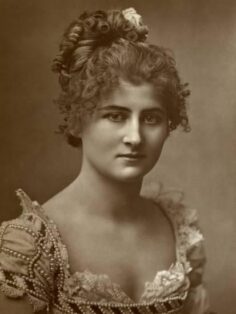
The angry hawk clenched its talons on the heavy leather gauntlet, stabbing the delicate wrist beneath. Wings batting, the half-wild bird glared fiercely into the large, gray eyes of his captor. Mary Anderson stared back with steely determination. This unruly bird would be tamed, she resolved, and would become a living prop for her performance of the Countess in Sheridan Knowles’ comedy, Love. A stuffed bird would not provide the realism she intended, and what Mary Anderson intended usually came to be.
“There is a fine hawking scene in one of the acts,” Mary wrote in her memoirs, “which would have been spoiled by a stuffed falcon, however beautifully hooded and gyved he might have been; for to speak such words as: ‘How nature fashion’d him for his bold trade, / Gave him his stars of eyes to range abroad, / His wings of glorious spread to mow the air, / And breast of might to use them’ to an inanimate bird, would have been absurd,” she declared. Always absolutely serious about her profession, Mary procured a half-wild bird and set to work on bending its spirit to her will.
“The training,” she explained, “started with taking the hawk from a cage and feeding it raw meat hoping thus to gain his affections.” She wore heavy gloves and goggles to protect her eyes. The hawk was not easily convinced of her motives, and “painful scratches and tears were the only result.”
She was advised to keep the bird from sleeping until its spirit broke, but she refused to take that course. Persevering with the original plan, Mary continued to feed and handle the hawk until it eventually learned to sit on her shoulder while she recited her lines, then fly to her wrist as she continued; then, at the signal from her hand, the bird would flap away as she concluded with a line about a glorious, dauntless bird.
The dauntless hawk and Mary Anderson were birds of a feather.

Entertaining Women 4
I'm looking forward to hearing from you! Please fill out this form and I will get in touch with you if you are the winner.
Join my email news list to enter the giveaway.
"*" indicates required fields
To learn more about Mary and other performers like her read
Entertaining Women: Actresses, Dancers, and Singers in the Old West

